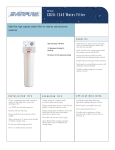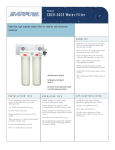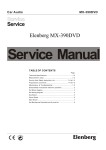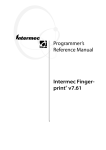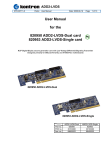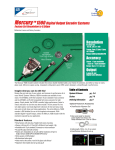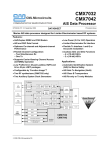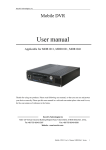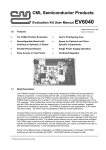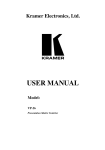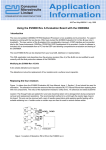Download EV9100 Evaluation Kit User Manual
Transcript
EV9100 CML Microcircuits COMMUNICATION SEMICONDUCTORS Evaluation Kit User Manual UM9100/1 August 2005 Advance Information Features • Target CMX910 installed • C-BUS interface • Auxiliary ADC and DAC interface • 19.2MHz device clock • Digital/analogue PCB with low noise floor • Interfaces to RF daughterboard with all necessary signals • Differential and single-ended baseband interface • On-board power regulation and distribution • FX604 FSK modem IC fitted for extra Rx channel 1 Brief Description The EV9100 evkit is available for the evaluation, experimentation and design-in of the CMX910 AIS Baseband Processor IC. Comprising a digital/analogue pcb with an on-board CMX910 device, the evkit provides access to the CMX910’s baseband signal, control and data interfaces as well as its auxilliary ADC and DAC functions. The evkit also provides an FX604 FSK modem and associated circuitry to allow evaluation of the CMX910's external FSK interface. Jumpers, links and test points allow the user to dynamically monitor and/or isolate all aspects of the IC’s signal and voltage levels. This evkit has a simple power requirement with on-board voltage regulation and distribution. © 2005 CML Microsystems Plc Evaluation Kit User Manual for CMX910 EV9100 CONTENTS Section Page 1 Brief Description ..................................................................................... 1 2. Preliminary Information.......................................................................... 4 2.1 Laboratory Equipment............................................................... 4 2.2 Handling Precautions ................................................................ 4 2.3 Approvals.................................................................................... 4 3. Quick Start ............................................................................................... 4 4. Signal Lists .............................................................................................. 5 5. Circuit Schematics and Board Layouts.............................................. 11 6. Detailed Description ............................................................................. 12 6.1 Hardware Description.............................................................. 12 6.2 Firmware Description .............................................................. 13 6.3 Software Description............................................................... 13 6.4 Evaluation Tests ...................................................................... 13 7. Performance Specification................................................................... 14 7.1 Electrical Performance ............................................................ 14 It is always recommended that you check for the latest product datasheet version from the Datasheets page of the CML website: [www.cmlmicro.com]. Note: This product is in development: Changes and additions will be made to this specification. Items marked TBD or left blank will be included in later issues. Information in this user manual should not be relied upon for final product design. © 2005 CML Microsystems Plc 2 UM9100/1 Evaluation Kit User Manual for CMX910 EV9100 TxI+ TxI- C-BUS C-BUS Header +3.3V TxQ+ TxQ- SLOTCLK UTC1PPS Reference Oscillator CMX910 AFC DAC4 TxI Rx Differential Reference RF Enables Tx Differential C-BUS Expansion Aux ADCs & DACs C-BUS RF Daughterboard Connector RxI+ RxI- TxQ RxI1 RxQ+ RxQ- RxQ1 RxI+ RxI- RxI2 RxQ+ RxQ- RxQ2 +3.3V Vin PSU FX604 +2.5V -3.3V FSK LimiterDiscriminator FSK In Figure 1 Block Diagram © 2005 CML Microsystems Plc 3 UM9100/1 Evaluation Kit User Manual for CMX910 2. Preliminary Information 2.1 Laboratory Equipment EV9100 The following laboratory equipment is needed to use this evaluation kit: 2.1.1 Power Supply +5V, -6V. The -6V supply is optional, as the EV9100 incorporates a negative voltage generator. The board is supplied with JP2 jumpered between pins 1 and 2, which connects the negative supply to the on-board negative voltage generator, rather than the -6V external supply. Note that the external negative supply connector is labelled -5V on the PCB. This is incorrect, it should read -6V. 2.1.2 Signal Generators and Analysers Suitable AIS Baseband I and Q signals must be generated by external equipment connected to this Evaluation Kit. The signals produced by this kit must also be analysed by external equipment. Provision is also made on this kit for connections to the Auxiliary ADC and DAC and digital Device Enable Ports. A multi-way connector, J10, allows for the connection of a (customer-supplied) daughter card containing RF circuitry. 2.1.3 C-BUS Control This Evaluation Kit is controlled by a (customer-supplied) host µController, via the C-BUS connector, J16. This is a 3.3V digital logic serial interface, which can be connected to a host µController's SPI port. There is no firmware or software supplied with this Evaluation Kit. 2.2 Handling Precautions Like most evaluation kits, this product is designed for use in office and laboratory environments. The following practices will help ensure its proper operation. 2.2.1 Static Protection This product uses low power CMOS circuits which can be damaged by electrostatic discharge. Partially damaged circuits can function erroneously, leading to misleading results. Observe ESD precautions at all times when handling this product. 2.2.2 Contents - Unpacking Please ensure that you have received all of the items on the separate information sheet (EK9100) and notify CML within 7 working days if the delivery is incomplete. 2.3 Approvals There are no approvals for this product. 3. Quick Start Customers should assemble all of the equipment required to demonstrate the CMX910 and connect it to the Evaluation Kit before applying power to the kit. Power should be applied to this kit before the host µController is powered-up. Consult sections 6 and 7.1.3 of this User Manual for details of the analogue and digital signal levels. © 2005 CML Microsystems Plc 4 UM9100/1 Evaluation Kit User Manual for CMX910 4. EV9100 Signal Lists CONNECTOR PINOUT Connector Ref Connector Pin No. Signal Name Signal Type Description J26 1 -Vin Power J26 2 DGND Power J26 3 +Vin Power +ve power supply. J16 1 CSN I/P Active low chip select. J16 2 CSXN I/P Active low chip select expansion input. J16 3 CDATA I/P Command Data (Data from host to CMX910). J16 4 SLOTCLKN O/P Active low AIS Slot Clock. J16 5 SCLK I/P Serial Clock. J16 6 UTC1PPS I/P 1Hz clock signal from GPS unit to CMX910. J16 7 RDATA O/P Reply data (Data from CMX910 to host). J16 8 RESETN I/P Active low reset. J16 9 IRQN O/P Active low interrupt. This is an open drain output from the CMX910. J16 10 DGND Power © 2005 CML Microsystems Plc 5 Optional -ve power supply. UM9100/1 Evaluation Kit User Manual for CMX910 EV9100 CONNECTOR PINOUT Connector Ref. Note: J18 Connector Pin No. Signal Name Signal Type Description On J18, odd-numbered pins are outputs from the single-to-differential op-amps. Even-numbered pins are inputs to the CMX910. See also the table of jumper settings. 1, 2 Rx1IN O/P - I/P Channel 1 Rx I Negative J18 3, 4 Rx1IP O/P - I/P Channel 1 Rx I Positive J18 5, 6 Rx1QN O/P - I/P Channel 1 Rx Q Negative J18 7, 8 Rx1QP O/P - I/P Channel 1 Rx Q Positive J18 9, 10, 11, 12 AGND Power J18 13, 14 Rx2IN O/P - I/P Channel 2 Rx I Negative J18 15, 16 Rx2IP O/P - I/P Channel 2 Rx I Positive J18 17, 18 Rx2QN O/P - I/P Channel 2 Rx Q Negative J18 19, 20 Rx2QP O/P - I/P Channel 2 Rx Q Positive J19 Rx1I I/P Channel 1 Rx I J20 Rx1Q I/P Channel 1 Rx Q J23 Rx2I I/P Channel 2 Rx I J25 Rx2Q I/P Channel 2 Rx Q © 2005 CML Microsystems Plc 6 UM9100/1 Evaluation Kit User Manual for CMX910 EV9100 CONNECTOR PINOUT Connector Ref. Note: J1 Connector Pin No. Signal Name Signal Type Description On J1, Odd-numbered pins are buffered outputs from the CMX910. Even-numbered pins are inputs to the differential-to-single op-amps. See also the table of jumper settings. 1, 2 TxIN O/P - I/P Tx I Negative J1 3, 4 TxIP O/P - I/P Tx I Positive J1 5, 6 AGND Power J1 7, 8 TxQN O/P - I/P Tx Q Negative J1 9, 10 TxQP O/P - I/P Tx Q Positive J14 FSK IN I/P FSK input J22 TxI O/P TxI Single ended J24 TxQ O/P TxQ Single ended J21 1 Aux ADC 0 I/P Auxillary ADC 0 Input J21 2 Aux ADC 1 I/P Auxillary ADC 1 Input J21 3 Aux ADC 2 I/P Auxillary ADC 2 Input J21 4 Aux ADC 3 I/P Auxillary ADC 3 Input J21 5 Aux ADC 4 I/P Auxillary ADC 4 Input J21 6, 7 AGND Power J21 8 Aux DAC 0 O/P Auxillary DAC 0 Output J21 9 Aux DAC 1 O/P Auxillary DAC 1 Output J21 10 Aux DAC 2 O/P Auxillary DAC 2 Output J21 11 Aux DAC 3 O/P Auxillary DAC 3 Output J21 12 Aux DAC 4 O/P Auxillary DAC 4 Output © 2005 CML Microsystems Plc 7 UM9100/1 Evaluation Kit User Manual for CMX910 EV9100 CONNECTOR PINOUT Connector Ref. Connector Pin No. Signal Name Signal Type Description J10 1 CDATA I/P Command Data J10 2 SCLK I/P Serial Clock J10 3 EXP1N I/P CBUS expansion 1 J10 4 EXP3N I/P CBUS expansion 3 J10 5 DGND Power Digital Ground J10 6 EXP4N I/P CBUS expansion 4 J10 7 ENAB0 O/P RF Enable 0 J10 8 ENAB2 O/P RF Enable 2 J10 9 ENAB4 O/P RF Enable 4 J10 10 DGND Power Digital Ground J10 11 UTC1PPS I/P 1Hz GPS clock J10 12 DGND Power Digital Ground J10 13 FSK_RXD I/P Demodulated FSK data J10 14 DGND Power Digital Ground J10 15 DGND Power Digital Ground J10 16 AGND Power Analogue Ground J10 17 VREF_EXT I/P External Voltage Ref. J10 18 AUXADC1 I/P Aux ADC 1 Input J10 19 AUXADC3 I/P Aux ADC 3 Input J10 20 AGND Power Analogue Ground J10 21 AUXDAC1 O/P Aux DAC 1 Output J10 22 AUXDAC3 O/P Aux DAC 3 Output J10 23 AGND Power Analogue Ground J10 24 RX1IP I/P Ch 1 Rx I Positive J10 25 RX1QP I/P Ch 1 Rx Q Positive J10 26 RX2IN I/P Ch 2 Rx I Negative J10 27 RX2QN I/P Ch 2 Rx Q Negative J10 28 AGND Power Analogue Ground J10 29 TXIP O/P Tx I Positive J10 30 TXQP O/P Tx Q Positive continued overleaf ... © 2005 CML Microsystems Plc 8 UM9100/1 Evaluation Kit User Manual for CMX910 EV9100 CONNECTOR PINOUT Connector Ref. Connector Pin No. Signal Name Signal Type Description J10 31 AGND Power Analogue Ground J10 32 TXQN O/P Tx Q Negative J10 33 TXIN O/P Tx I Negative J10 34 RX2QP I/P Ch 2 Rx Q Positive J10 35 RX2IP I/P Ch 2 Rx I Positive J10 36 AGND Power Analogue Ground J10 37 RX1QN I/P Ch 1 Rx Q Negative J10 38 RX1IN I/P Ch 1 Rx I Negative J10 39 AUXDAC4 O/P Aux DAC 4 Output J10 40 AUXDAC2 O/P Aux DAC 2 Output J10 41 AUXDAC0 O/P Aux DAC 0 Output J10 42 AUXADC4 I/P Aux ADC 4 Input J10 43 AUXADC2 I/P Aux ADC 2 Input J10 44 AUXADC0 I/P Aux ADC 0 Input J10 45 FSK_IN I/P FSK Modulation J10 46 +VIN Power Unregulated Supply J10 47 +3V3_EXT O/P +3.3V supply, 100mA maximum J10 48 FSK_MUTE I/P Logic Input J10 49 FSK_DET I/P Logic Input J10 50 REFCLK O/P CMX910 Clock J10 51 nSLOTCLK O/P AIS Slot Clock J10 52 ENAB5 O/P RF Enable 5 J10 53 ENAB3 O/P RF Enable 3 J10 54 ENAB1 O/P RF Enable 1 J10 55 nEXP5 I/P CBUS expansion 5 J10 56 DGND Power Digital Ground J10 57 IRQN O/P Active low interrupt J10 58 EXP2N I/P CBUS expansion 2 J10 59 EXP0N I/P CBUS expansion 0 J10 60 RDATA O/P Reply data © 2005 CML Microsystems Plc 9 UM9100/1 Evaluation Kit User Manual for CMX910 EV9100 TEST POINTS Test Point Ref. Default Measurement Description TP1, 2 0V Digital ground TP3, 4 0V Analogue ground TP27 3.3V 3.3V digital supply TP28 3.3V 3.3V external supply TP29 2.5V 2.5V digital supply JUMPERS Link Ref. Positions Default Position J15 1-2, 2-3 2-3 J18 1-2, 3-4, 5-6, 7-8 All fitted Connect single-to-differential op-amp circuit outputs for Rx Channel 1 to CMX910, if fitted. J18 13-14, 15-16, 17-18, 19-20 All fitted Connect single-to-differential op-amp circuit outputs for Rx Channel 2 to CMX910, if fitted. J1 1-2, 3-4, 7-8, 9-10 All fitted Connect CMX910 Tx outputs to differential-to-single opamp circuit inputs, if fitted. JP1 1-2 Not Fitted If fitted, the tri-state buffers between the FX604 and the CMX910 will be disabled i.e. their outputs will be high impedance. JP2 1-2, 2-3 1-2 JP13 1-2 Fitted Voltage reference select. If fitted, the CMX910's internal reference will be used as a reference for the differential-tosingle Tx op-amp circuit. If not fitted, then an external reference can be supplied from the RF transceiver interface (J10). JP14 1-2 Not Fitted External regulator control. If fitted, an external 2.5V regulator will be enabled. This is not necessary for normal operation. JP15 1-2 Not Fitted If a jumper is fitted to JP15 then the negative voltage converter will be shut down. Default state is not fitted. Notes: I/P = O/P = BI = © 2005 CML Microsystems Plc Description FSK_MUTE select. 1-2 is high, disabling CMX910 interface, 2-3 is low, enabling CMX910 interface. Negative voltage supply selection. 1-2 is on-board switched-mode supply, 2-3 is external supply. Input Output Bidirectional 10 UM9100/1 Evaluation Kit User Manual for CMX910 5. EV9100 Circuit Schematics and Board Layouts For clarity, circuit schematics are available in this kit as separate high resolution files. Figure 2 Evaluation Board - Layout © 2005 CML Microsystems Plc 11 UM9100/1 Evaluation Kit User Manual for CMX910 6. Detailed Description 6.1 Hardware Description EV9100 6.1.1 CMX910 The EV9100 comprises a CMX910 device mounted on a PCB with convenient interfaces so that users can rapidly develop their own CMX910 prototype circuits and make connections to user-provided external circuits. Refer to the CMX910 data sheet for a detailed description of the IC's operation. The CMX910 is a highly integrated baseband signalling processor IC, which meets the requirements of the class A and class B marine Automatic Identification System (AIS) transponder market. It is half duplex in operation, comprising two parallel I+Q Rx paths and one Tx path. These are configurable for AIS or FSK (DSC) operation. A 1200bps FSK demodulator interface provides the third parallel decode path required by the AIS class A market. Integrated Rx/Tx data buffers and a slot/sample timer are also provided, reducing the processing required by the host µC. A C-BUS expansion port, an RF device enable port and a number of auxiliary ADCs and DACs are also provided. There is a push-to-make switch on the pcb, connected to the CMX910's nRESET pin. 6.1.2 Oscillator The clock for the CMX910 is provided by a 19.2MHz VCTCXO. By default its control input is held at midrail, but it can be tuned using the CMX910 AuxDAC4. If this is required, fit a 5k6Ω resistor in position R19. 6.1.3 Rx Signal Conditioning The Rx inputs to the CMX910 are differential. The header J18 can be used to apply differential signals (max 0.85Vpp per pin, centred at 1.25V) via anti-alias filters. Alternatively, jumpers can be fitted to J18 and single ended signals applied to the SMA connectors J19 and J20 (Ch1) and/or J23 and J25 (Ch2). On-board op-amps (U18, U20) then perform single-ended to differential conversion and shift the signal to the appropriate DC level. The signals applied to the SMA connectors should be DC coupled and centred about 0V. Maximum signal level at the SMA connectors is 0.85Vpp. 6.1.4 Tx Signal Conditioning The Tx outputs from the CMX910 are differential. These signals pass through an RC filter and a buffer and are available on J1. Alternatively, jumpers can be fitted on J1 and on-board op-amps (U19) then perform differential to single-ended conversion and level shifting. The single-ended outputs are available on SMA connectors J22 and J24. These signals are centred about 0V and are capable of driving a 50Ω load. These outputs are not designed to drive large capacitive loads. 6.1.5 FX604 The EV9100 has an FX604 FSK modem IC interfaced to the CMX910's 1200bps FSK demodulator interface. The FX604 is enabled by the signal ENAB4. The CMX910's FSK_MUTE pin can be manually pulled up or down via J15, or driven from the RF transceiver interface. This is likely to be driven by a 'squelch' output from a limiter-discriminator. The FX604 outputs can be isolated from the CMX910 by fitting a jumper to JP1. The input to this circuit is an SMA connector, J14. 6.1.6 Digital Interface Digital signals can be found on J16. These include the C-BUS interface, as well as some discrete logic signals. All digital signals use 3.3V levels. 6.1.7 RF Transceiver Interface J10 is intended to allow the connection of a daughter card containing RF circuitry. This connector is manufactured by JAE and has the part number TX14-60R-6ST-MH1. The mating half is part number TX15-60P-6ST-MH1. In the UK they can be purchased from Farnell Electronic Components (388-7790 and 388-7870). Note that this connector is numbered 1-30 along one edge, then 31-60 in the opposite direction along the other edge. 6.1.8 Power Distribution System The EV9100 is designed to be operated from a single +5V (nominal) supply. The EV9100 circuitry runs from +3.3V and +2.5V supplies which are generated using on board linear regulators. There is also an on board negative voltage converter to provide the -3.3V for the Tx and Rx op-amps. If required, this can be © 2005 CML Microsystems Plc 12 UM9100/1 Evaluation Kit User Manual for CMX910 EV9100 disabled by fitting a jumper to JP15. In this case, the jumper on JP2 should be moved from pins 1 and 2 to pins 2 and 3, and -6V applied to pin 1 of J26. A separate +3.3V supply is used to power the circuitry on the daughtercard. This is capable of supplying 100mA maximum. 6.1.9 Options 6.1.9.1 External Reference An external voltage reference (VREF_EXT) can be applied from the RF Transceiver interface. In this case the jumper should be removed from JP13. This will have the effect of centring the differential Tx I and Q signals about VREF_EXT. 6.1.9.2 AuxADC Signal Conditioning AuxADC0, AuxADC1 and AuxADC2 have uncommitted op-amps on their inputs. These op-amps are configured as non-inverting followers by default, but the PCB is arranged so that other configurations are possible by changing component values. 6.2 Firmware Description There is no firmware required with this Evaluation Kit. 6.3 Software Description There is no software supplied with this Evaluation Kit. Customers must supply their own software, compatible with their chosen µController. 6.4 Evaluation Tests This Evaluation Kit is capable of being used to demonstrate the following functions: • • • • • • • • • • • • • Receive AIS25 and AIS12.5 bursts in AIS burst mode. Receive AIS25 and AIS12.5 bursts in AIS raw mode. Receive DSC bursts using internal modem. Receive DSC bursts using external FX604 modem. Transmit AIS25 and AIS12.5 bursts in AIS burst mode. Transmit AIS25 and AIS12.5 bursts in AIS burst mode. Transmit DSC bursts. CS-TDMA sensing and transmit abort. Synchronisation to external UTC clock. Sleep mode. Control of external RF circuitry. C-BUS expansion. Auxilliary converters. © 2005 CML Microsystems Plc 13 UM9100/1 Evaluation Kit User Manual for CMX910 7. Performance Specification 7.1 Electrical Performance EV9100 7.1.1 Absolute Maximum Ratings Exceeding these maximum ratings can result in damage to the Evaluation Kit. Min. -0.3 +0.3 -0.3 0 -10 +10 Supply (+VIN - VSS) Supply (-VIN - VSS) Voltage on any connector pin to VSS Current into or out of VIN and VSS pins Storage Temperature Operating Temperature Max. 12.0 -12.0 VDD + 0.3 ±250 +70 +35 Units V V V mA °C °C Max. 5.5 -7.0 +35 Units V V °C 7.1.2 Operating Limits Correct operation of the Evaluation Kit outside these limits is not implied. Notes Supply (+VIN - VSS) Supply (-VIN - VSS) Operating Temperature 1 Min. 4.5 -6.0 +10 Notes: 1. Negative supply is optional, so this pin may be left unconnected. © 2005 CML Microsystems Plc 14 UM9100/1 Evaluation Kit User Manual for CMX910 7.1.3 EV9100 Operating Characteristics For the following conditions unless otherwise specified: +VIN - VSS = 5.0V; External Negative Supply not connected; default jumper positions; Tamb = +25°C; CMX910 Xtal Oscillator Frequency = 19.2MHz. Notes Min. DC Parameters IDD (immediately after power on) IDD (Operating) Typ. Max. 100 160 6 3V3 External Daughtercard Supply AC Parameters Tx Single-ended Outputs Tx O/P voltage swing Tx O/P DC offset Minimum Load impedance 3.15 2 3 Tx Differential Outputs Tx O/P voltage swing Tx O/P DC offset Minimum Load impedance 4 5 Rx Single-ended Inputs Rx I/P max voltage swing Rx I/P DC Offset Input impedance 2 Rx Differential Inputs Rx I/P max voltage swing Rx I/P DC Offset Input impedance 3.30 mA mA 3.45 2 V 2.0 0 50 Vp-p V Ω 2.1 1.25 2 Vp-p V kΩ 0.85 0 10 Vp-p V kΩ 0.85 1.25 Vp-p V kΩ 1.0 0 10 Vp-p V kΩ 100 FSK Input FSK I/P max voltage swing FSK I/P DC Offset Input impedance Units Notes: 2. DC Coupled. 3. These outputs are not designed to drive highly capacitative loads. 4. Peak-to-peak differential i.e. 1.05Vp-p on each pin. 5. Or VREF_EXT. See section 6.1.9.1. 6. This voltage rail is generated by the EV9100 to supply the daughtercard. Iout < 100mA. © 2005 CML Microsystems Plc 15 UM9100/1 Evaluation Kit User Manual for CMX910 EV9100 CML does not assume any responsibility for the use of any circuitry described. No IPR or circuit patent licences are implied. CML reserves the right at any time without notice to change the said circuitry and any part of this product specification. Evaluation kits and demonstration boards are supplied for the sole purpose of demonstrating the operation of CML products and are supplied without warranty. They are intended for use in a laboratory environment only and are not for re-sale, enduse or incorporation into other equipments. Operation of these kits and boards outside a laboratory environment is not permitted within the European Community. All software/firmware is supplied "as is" and is without warranty. It forms part of the product supplied and is licensed for use only with this product, for the purpose of demonstrating the operation of CML products. Whilst all reasonable efforts are made to ensure that software/firmware contained in this product is virus free, CML accepts no resonsibility whatsoever for any contamination which results from using this product and the onus for checking that the software/firmware is virus free is placed on the purchaser of this evaluation kit or development board. www.cmlmicro.com For FAQs see: www.cmlmicro.com/products/faqs/ For a full data sheet listing see: www.cmlmicro.com/products/datasheets/download.htm For detailed application notes: www.cmlmicro.com/products/applications/ Oval Park, Langford, Maldon, Essex, CM9 6WG - England. 4800 Bethania Station Road, Winston-Salem, NC 27105 - USA. No 2 Kallang Pudding Road, #09 - 05/06 Mactech Industrial Building, Singapore 349307 No. 218, Tian Mu Road West, Tower 1, Unit 1008, Shanghai Kerry Everbright City, Zhabei, Shanghai 200070, China. Tel: +44 (0)1621 875500 Tel: +65 6745 0426 Fax: +44 (0)1621 875600 Tel: +1 336 744 5050, 800 638 5577 Fax: +1 336 744 5054 Fax: +65 6745 2917 Tel: +86 21 6317 4107 +86 21 6317 8916 Fax: +86 21 6317 0243 Sales: [email protected] Sales: [email protected] Sales: [email protected] Sales: [email protected] Technical Support: [email protected] Technical Support: [email protected] Technical Support: [email protected] Technical Support: [email protected]

















